Archive for the ‘Stadium Roofs’ Category
Stadium Roof Material Makes Its Mark
 As the installation of the roof goes up on the new Viking football stadium, many questions have been raised about some of the materials being used. Covering some 240,000 square feet, the new stadium will be largest in North American to use ETFE.
As the installation of the roof goes up on the new Viking football stadium, many questions have been raised about some of the materials being used. Covering some 240,000 square feet, the new stadium will be largest in North American to use ETFE.
Coatings to Coverings
ETFE, or ethylene-tetraflouroethylene, is a co-polymer resin that is extruded into a thin film. The plastic-like material is use to create a durable, yet light weight, covering for the roof of buildings. Unlike glass, ETFE is corrosion resistant; while also blocking out much of the sun’s harmful UV rays. Even with its weight 1/100 of that of traditional glass materials, ETFE can handle snow and wind loads comparable to other roof materials.
For the new Viking stadium in Minnesota, the ETFE roof will allow for sunlight to reach the stadium seats and reduce the chances the building suffers another devastating roof collapse. Although ETFE isn’t a household name in roofing, there are many notable facilities around the world already benefiting from this great product. The Water Cube building in Beijing, China, the Eden project in Cornwall, UK, and the Allianz Arena in Munich, Germany are just some of the noteworthy buildings boasting ETFE roofs.
Domed Roof to Catch Rainwater
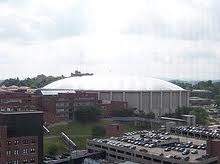
In Syracuse New York, Syracuse University received a $1.35 million state grant to install a rainwater collection system for the Carrier Dome. The 7 acre fabric roof will collect 6.6 million gallons of water from the approximately 880,000 that pours off the Dome roof every year.
The water will run off the roof material and be stored in tanks at the bottom of the bleachers. The retained water will be used during events to flush toilets in the 16 public bathrooms. The water will be dyed to prevent confusion between toilet water and drinking water.
The Gutter is Wide Enough To Hold a Car
The water runoff roof system includes a gutter that runs the entire edge of the bottom of the roof. The gutter is heated in the winter to prevent ice buildup and is approximately 10 feet wide.
The water is held in 4 tanks that hold 5,000 gallons of rainwater each. The tanks at Carrier Dome will hold enough water to flush the toilets and urinals during two major sporting events.
The State Environmental Facilities Corp. grant will pay for most of the rainwater collection system to include the tanks, pipes, filtration and chlorination system. Syracuse University will cover the remaining cost of the $1.5 million project.
The university wants the public to notice the water harvesting system to demonstrate how such systems can conserve municipal water supplies while reducing the amount of rainwater into an overloaded wastewater treatment system.
Bruce Wanlass, principle engineer for C&S Engineers came up with the idea for the system while we was attending a basketball game with his 7 year old son.
Stadium with Inverted Curve Roof Demolished

The Moose Jaw Civic Center in Moose Jaw Saskatchewan Canada affectionately known as The Crushed Can, has been torn down after 53 years. The award winning hockey arena’s roof was suspended by cables giving it a curved suspension ceiling spanning 192 feet.
Architect Joseph Pettick and Vancouver structural engineer J.L. Miller designed the arena. The building won the Massey Medal for architecture for the innovative cable roof structure giving the building its unique shape. Built in 1959 the arena was nicknamed the crushed can due to the curved appearance of the building.
Iconic Sloping Roof
The roof sloped to within 12 feet at the center of the arena. Roof problems were visible when dripping water from the leaking roof would freeze it would be 1-2 inches in front of the net according to the maintenance man.
The arena has been criticized as being too small and not up to the Moose Jaw Warrior’s hockey team standards.
Saskatchewan City had been gutting the building while waiting to see if the private sector would come through with a compelling new use or demolition of the iconic arena. When no private investors agreed to preserve the building and complete needed roof repairs, demolition plans began.
To demolish the building the crew used jackhammers at the structure and bottom so the building would lose integrity and fall in on itself. They were able to save 15,000 cubic yards of concrete to be crushed and reused for other projects.
A new 4,367 seat hockey arena was built at Mosaic Place in Downtown Saskatchewan for the Moose Jaw Warriors.
Kitchener Auditorium Roof Remodel
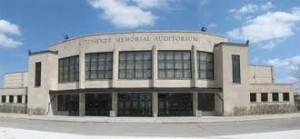
The Kitchener Auditorium in Southern Ontario has raised the roof as part of the remodel. The auditorium commonly known as “the Aud” to residents received a $12 million retrofit.
The construction was going on while the auditorium was still being used making for some difficult challenges. The structural steel addition was built over the top of the auditorium. The old roof was not able to come down until the new roof was weather tight; problem was the cranes were too big to fit inside the building for the demo job.
Crane Lines Lowered into Holes in Roof
They made holes in the new roof for the crane lines to pass to demolish the old roof, including the roof membrane and deck. The old roof materials were taken apart from one end and then rolled across the roof on carts to be hoisted down the exterior wall. The steel beams had to be lowered and then cut up and removed.
Structal of Quebec fabricated the new steel structure and roof. And ES Fox Ltd. Of St. Catharine’s erected the steel. About a dozen carpenters were on hand to complete millwork, concrete formwork and other elements.
The demolition was completed in 3 weeks and the 60 year old building was remodeled in time for the Rangers first home game on October 19th.
Kitchener Auditorium was officially opened in May 1951; the building had state of the art flooring which allowed the conversion from a hockey arena to a concert hall in 24 hours. It was the 4th largest of its kind in Ontario.
Largest Dome Roof for Singapore
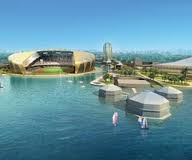
The Singapore Sports Hub in Kallang will soon be getting the worlds’ largest dome roof over the new National Stadium. The 310m dome will cover the whole 55,000 seat capacity stadium plus the multi-purpose field. Spending $1.33 billion, the steel roof can be open or closed within 25 minutes.
The 20,000sqm retractable roof will surpass the current largest roof which is the Cowboys Stadium in Arlington Texas. Construction of the roof began in June and is expected to be completed within 2 years for the official opening in April 2014.
Roofers Getting the Work Done
Contract Director Chen Shee Shann of Dragages Singapore, one of the equity partners said “we awarded the contract for the steel roof structure early last year and by November or December we got all the roof materials in and started fabrication. That part of the risk is already over, now it’s getting the work done.”
One of the designers of the roof, Clive Lewis of Arup said “on the critical path, the dome roof is one of the first things we worked on.”
The stadium is being built on the site of the previous national stadium which was closed in June 2007. Construction delays have slowed down the progress originally planned for completion in 2011.
The sports hub is the largest sports facilities infrastructure project in the world. With its world class facilities, the Sports Hub will be the center for Singapore’s elite athletes as well as an ideal location for sports and entertainment events.
Wind Rips Off Stadium Roof
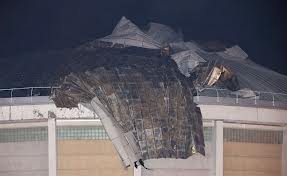
In Montreal Canada Thursday 16,800 square feet of aluminum roof membrane was ripped from the roof of the Maurice Richard Arena. No one was injured when the violent 60 kilometers an hour wind crumpled the arena roof.
The arena has been undergoing renovations for the past two weeks, 60 percent of the roof membrane had already been removed. The full renovation project is scheduled to be finished by early January.
$3 Million Roof Work
Part of the $5.7 million renovation includes replacing the roof membrane with a new roof of stainless steel covering half a millimeter thick. Any extra costs due to the storm are expected to be covered by the contractor’s insurance company.
When the crew arrived to work on Friday morning they discovered peeled back sections of the metal roof hanging from the southern edge of the dome and parts of the roof had been blown onto the nearby arena grounds.
Approximately 1/8 of the original roof membrane was left intact on the roof. The 60,000 square foot arena and original circular dome were built back in 1958.
Viking Stadium Roof Design Up In The Air
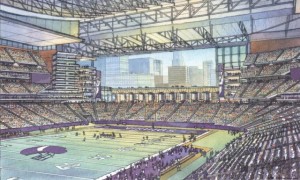 The Minnesota Vikings have been planning their new stadium for quite some time. After much debate over the design of the building, engineers cannot agree on the style of the new roof.
The Minnesota Vikings have been planning their new stadium for quite some time. After much debate over the design of the building, engineers cannot agree on the style of the new roof.
Retractable Roof
30 seasons in an aging building has Viking fans excited about the plans for a new stadium. However, the roof of the new Vikings stadium is undecided as design team members argue over whether or not the stadium should have a retractable roof. While some are pushing for the high tech roof design, others insist that the retractable feature is not necessary and will only drive up the price to build the new stadium.
Owner Zygi Wilf has been on board with the idea of a retractable roof since day one, but budget concerns have recently brought up the reality of the design. Early estimates reveal an additional $25 million or more for a retractable roof, money that some insist could be better spent elsewhere in the stadium. Wilf says, “it’s a competitive landscape to attract our fans to the facility, and we’re going to want to make it something special. To the extent that (a retractable roof) can get there, we’re going to try to do it.”
Stadium Roof Collapse due to Faulty Design
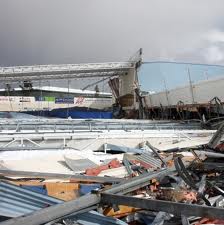
The $10 million roof at Southland Stadium in Invarcargill New Zealand, buckled in 2010 due to heavy snow, construction defects and design problems. Approximately 30 people were inside the stadium when it collapsed, fortunately no one was hurt.
Nearly 18 months after the collapse, the conclusions were released in a detailed report by consultants at the Department of Building and Housing. The investigation was performed by Hyland Fatigue and Earthquake Engineering using site examination, laboratory testing and 3-D computer analysis.
Defective Design
The report also stated that sagging was noticed when the new roof was first being built and the subsequent roof repair work was inadequate. It also states “defects in the construction of the steel tube truss roof, particularly those portions that involved welding on site, appear to have significantly reduced the ability of the roof to sustain the intended design loads and the snow load experienced at the time of the collapse.”
Insurers for the Southland Indoor Leisure Centre Charitable Trust are suing Invercargill City Council and the consulting engineer for $27 million. The disagreements are over the substandard building design and construction.
The Building and Construction Minister Maurice Williamson said “These are serious issues that have been properly investigated.” The report was sent to the police and Department of Labor and the Institution of Professional Engineers New Zealand (IPENZ).
$1 Million Repair Estimate for BC Place Roof
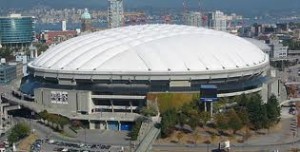
BC Place Stadium owners are going to court to determine who will pay for the million dollar roof repairs to Vancouver BC Place Stadium. During a pre-trial conference this week lawsuits were filed by the sub-contractor on the $563 million renovation of the stadium and countersuit by the general contractor.
Lubricants needed to allow the cables to flex have leaked onto the $30 million fabric roof. BC place owners BC Pavilion Corp., contend the problem is with the contractor and the estimated $1 million to fix the problem resides with the contractor since it was a fixed price contract.
Millions of Dollars in Law Suit
The roof subcontractor Freyssinet, a French company, is claiming in a lawsuit that they are still owed $6.5 million of the $30 million contract. They are suing BC Pavilion Corp, the Canam Group and PCL Constructors Westcoast Inc. The $30 million was for engineering and fabrication of the cable and cast steel connections.
Canam is countersuing for $26 million, they deny owing Freyssinet any money and claim Freyssinet supplied cables that continue to leak grease and oil and causing extra expense. Canam claims Freyssinet breached the sub contract because they failed to perform the cable work in a proper workmanlike and timely manner. “An inefficient and unworkable construction methodology for the cable erection, significantly underestimating the cost of the cable erection.”
The case is scheduled to go to trial in October 2013.
Hersheypark Arena gets Roof Update
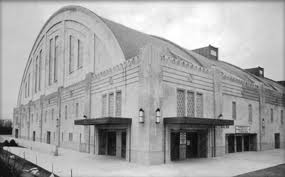
Hershey Pennsylvania, Hersheypark Arena (originally Hershey Sports Arena) will get a new rubber membrane roof in 2012. Hershey Entertainment says the roof repair will cost $2.5 million.
The project is expected to take about 5 months to complete. The last time the rubber membrane was replaced was in the early 1990’s. The old rubber membrane will be removed and after repairs are made to the concrete roof, a new rubber membrane will be installed. The new roof and rubber membrane is expected to last 10-15 years.
A Big Part of the Community
The arena is a big part of the community and still used for Hersey Bear practices, youth, high school and Lebanon Valley College hockey, figure skating and various other events. The arena also has 100 offices for Hershey Entertainment employees and warehouse space and refrigerated food storage for Hersheypark.
The arena does not make enough money to make it profitable anymore, but they are committed to keeping the arena open for the community.
Bill Simpson, President and COO of Hershey Entertainment and Resorts Co said “It’s the heart of the community since it was built, I don’t think people appreciate how much the building is still being used. It is the focal point of the operations of the park and our company.”






